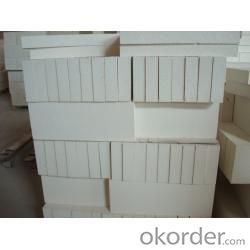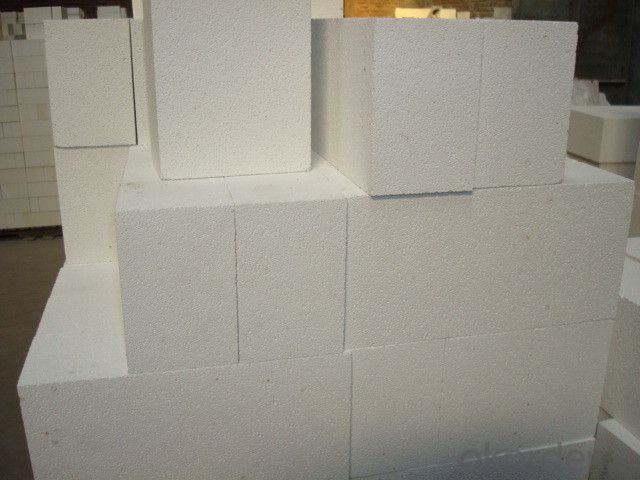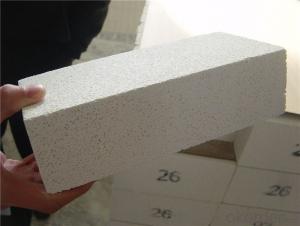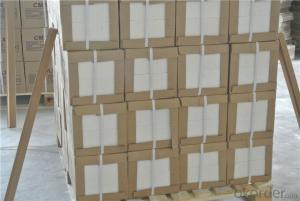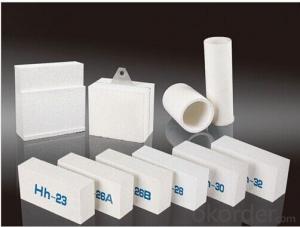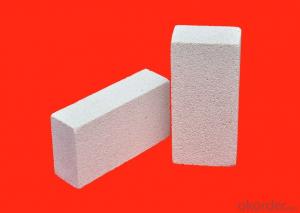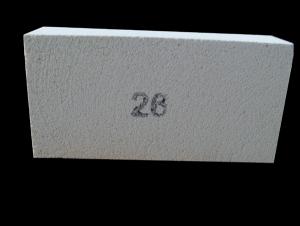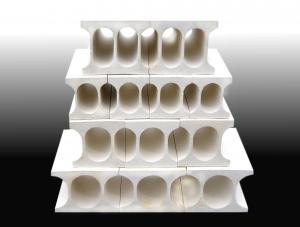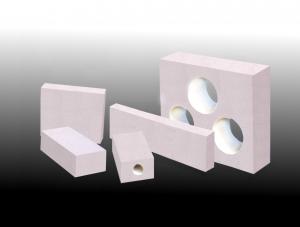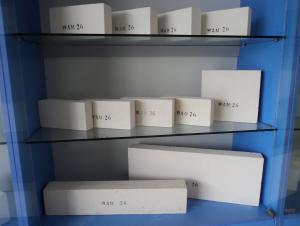Mullite Insulating Fire Brick - Thermal Storage & Thermal Insulating Brick
- Loading Port:
- Shanghai
- Payment Terms:
- TT OR LC
- Min Order Qty:
- 1 m.t.
- Supply Capability:
- 1000 m.t./month
OKorder Service Pledge
OKorder Financial Service
You Might Also Like
CNBM conforms strictly to the requirements of ISO 9000 quality control system during the production. MSDS is also available if you want. The thermal insulation fire clay brick meet with the requirements of ASTM & JIS standards. So please stay cool with our quality.
Application
Insulating Fire Brick are used for the lining of converter, alternating current arc furnace, direct Current arc furnace and the ladle slag line, etc.
Insulating Fire Brick Technical index
Brand Quality | JM23 | JM26 | JM28 | JM30 | JM32 | |
Bulk Density (g/cm3) | 0.52 | 0.78 | 0.88 | 1.03 | 1.25 | |
1.2 | 1.6 | 2.1 | 2.5 | 3.5 | ||
Modulus of Rupture (Mpa) | 0.9 | 1.4 | 1.6 | 2.1 | 2.1 | |
-0.5 | 1400℃ -0.4 | 1510℃ -0.5 | 1620℃ -0.9 | 1730℃ -0.9 | ||
Thermal Expansion 1100℃(%) |
0.5 |
0.7 |
0.8 |
0.9 |
1.1 | |
Thermal conductivity(W/m.k)
| 400℃ | 0.14 | 0.27 | 0.32 | 0.41 | 0.49 |
600℃ | 0.16 | 0.29 | 0.34 | 0.43 | 0.50 | |
800℃ | 0.18 | 0.31 | 0.36 | 0.44 | 0.51 | |
1000℃ | 0.20 | 0.33 | 0.38 | 0.45 | 0.53 | |
Al2O3 | 37 | 58 | 67 | 73 | 77 | |
Fe2O3 | 0.7 | 0.7 | 0.6 | 0.5 | 0.4 | |
Equipment
1 unit of Ceramic Abrasive (SG Abrasive) pilot production line
2 units of Compact grain Abrasive pilot production lines
1 unit of high-end coated abrasives (abrasive cloth) production line
2 units of Boron Carbide production lines
3 large flexible crushing and sieving lines for grit production lines
2 units of 2000KVA furnaces for Boron Carbide fusion
6 units of 5000KVA-10000KVA dumping type electric arc furnaces for Brown Fused Alumina fusion
Company Advantage
(1)Long Insulating Fire Brick manufacture history: 25 years manufacturer
(2)Advanced equipment
(3)Diversification of production standards: ISO ANSI FEPA JIS ASTM
(4)Flexible payment: T/T L/C D/P D/A
(5)Professional marketing team and after-sale service
(6)Free sample

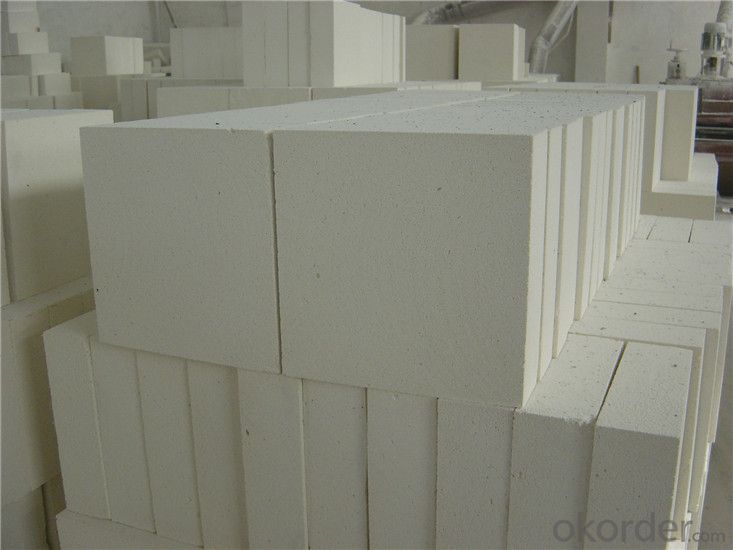
- Q: Can insulating fire bricks be used for insulation in walls or roofs?
- Insulating fire bricks are primarily designed for use in high-temperature applications, such as furnaces, kilns, and fireplaces. While they offer excellent thermal insulation properties, they may not be the best choice for insulation in walls or roofs of residential or commercial buildings. Insulating fire bricks are often made from lightweight refractory materials, such as ceramic fibers or expanded clay. These materials are highly resistant to heat, but they may not provide sufficient insulation against cold temperatures or moisture. Additionally, their structural integrity may not be suitable for load-bearing applications or other requirements specific to walls or roofs. For insulation in walls or roofs, it is generally recommended to use materials specifically designed for building insulation purposes, such as fiberglass batts, spray foam insulation, or rigid foam boards. These materials are better suited to provide both thermal and moisture resistance, as well as meet the necessary structural requirements. In summary, while insulating fire bricks may offer excellent thermal insulation properties, they are not typically recommended for use in walls or roofs. It is advisable to consult with a building professional or insulation specialist to determine the most suitable insulation materials for your specific needs.
- Q: Is sintering insulation brick good or concrete porous brick good?
- Thermal insulation brick is functional material, it is better than porous brick in thermal insulation. At the same time, the internal heat preservation material, so the overall cost is more, the hole brick should be higher.
- Q: Can insulating fire bricks be used in high-temperature kilns for pottery?
- Yes, insulating fire bricks can be used in high-temperature kilns for pottery. These bricks are specifically designed to withstand and retain heat, making them suitable for use in kilns that reach high temperatures. They help to insulate the kiln, preventing heat loss and allowing for more efficient firing of pottery.
- Q: The insulation layer destroyed after use of cement paste and tiling
- Put on the insulating layer and paste it with cement.Some students worry about the insulation layer and the wall adhesive strength is not enough, do not worry about, now developers are building exterior insulation and then on top of the tiling. Because after finishing the insulation layer, the contractor should check the construction to do a pullout test, the purpose is to prevent the strength can not meet the requirements.
- Q: Can insulating fire bricks be used in the construction of brick kilns?
- Yes, insulating fire bricks can be used in the construction of brick kilns. Insulating fire bricks are specifically designed to have high thermal resistance, which makes them ideal for applications where insulation is required. In brick kilns, insulating fire bricks can be used to line the walls, floor, and roof of the kiln, helping to retain heat and improve energy efficiency. These bricks are capable of withstanding high temperatures and can provide insulation against the heat generated during the firing process. Additionally, insulating fire bricks can also help reduce heat loss, resulting in faster and more efficient firing cycles. Overall, using insulating fire bricks in the construction of brick kilns can enhance their performance and contribute to more effective and sustainable kiln operation.
- Q: Are insulating fire bricks resistant to phosphorus pentoxide?
- Insulating fire bricks are generally not resistant to phosphorus pentoxide. Phosphorus pentoxide is a highly reactive compound that can corrode and degrade most materials, including insulating fire bricks. It is important to consider alternative materials or protective coatings if there is a need for resistance to phosphorus pentoxide in a specific application.
- Q: Are insulating fire bricks suitable for insulation in chemical reactors?
- Insulating fire bricks are often used for insulation in chemical reactors due to their excellent thermal properties and resistance to high temperatures. These bricks are made from lightweight refractory materials such as alumina, silica, and other minerals, which provide insulation against heat transfer. They have low thermal conductivity and high heat capacity, allowing them to effectively reduce heat loss and maintain stable temperatures inside the reactor. Chemical reactors often operate at high temperatures and may contain corrosive or reactive substances. Insulating fire bricks are able to withstand these harsh conditions and protect the reactor from external heat sources. They are chemically inert and resistant to corrosion, making them suitable for use with various chemicals and reactants. Additionally, insulating fire bricks have a low thermal expansion coefficient, which means they can withstand thermal cycling without cracking or deforming. This is crucial in chemical reactors where temperature changes are frequent and can cause damage to the equipment. Overall, insulating fire bricks are a popular choice for insulation in chemical reactors due to their thermal insulation properties, chemical resistance, and ability to withstand high temperatures and thermal cycling. Their use helps to improve the efficiency and safety of chemical processes by maintaining optimum operating conditions inside the reactor.
- Q: Are insulating fire bricks suitable for use in residential fireplaces?
- Depending on the homeowner's specific requirements and preferences, insulating fire bricks can be a suitable option for residential fireplaces. These bricks are designed to have low thermal conductivity, which effectively retains heat and prevents its escape from the fireplace. Consequently, less heat is lost through the bricks, resulting in more efficient and effective heating of the room. Moreover, insulating fire bricks are lightweight and easy to handle, making them a convenient choice for homeowners who wish to install or replace bricks themselves. Additionally, they are durable and can withstand high temperatures, ensuring their longevity when exposed to the intense heat produced by the fire. Nevertheless, it is crucial to recognize that insulating fire bricks may not be ideal for everyone. Traditional fire bricks, being denser with higher thermal mass, can absorb and radiate heat for a longer duration. This attribute creates a more consistent and long-lasting heat output, which may be preferred by some homeowners. Ultimately, the decision to use insulating fire bricks in a residential fireplace should be based on the specific needs and preferences of the homeowner. Seeking guidance from a professional fireplace installer or a reputable supplier can help ensure that the chosen bricks are suitable for the intended use.
- Q: Can insulating fire bricks be used in blast furnaces?
- Insulating fire bricks have the capability to be utilized in blast furnaces. These bricks are specifically designed to endure high temperatures and provide exceptional thermal insulation. Blast furnaces operate under extreme temperatures, typically reaching around 1500°C (2732°F), and thus require materials that can withstand such harsh conditions. Insulating fire bricks are constructed from lightweight substances like ceramic fibers, which possess low thermal conductivity and effectively retain heat. This makes them highly suitable for lining the walls and roofs of blast furnaces as they aid in energy conservation, minimize heat loss, and enhance overall furnace efficiency. Moreover, the use of insulating fire bricks in blast furnaces also serves to safeguard the structural integrity of the furnace by reducing thermal stress and preventing excessive heat transfer to the surrounding environment. Ultimately, the incorporation of insulating fire bricks in blast furnaces contributes to enhanced performance, energy preservation, and prolonged furnace lifespan.
- Q: Do insulating fire bricks require any special insulation blankets or jackets?
- Insulating fire bricks (IFBs) possess exceptional insulating properties, rendering them generally exempt from the need for specialized insulation blankets or jackets. However, in certain circumstances and environments, supplementary insulation may prove necessary. In cases where IFBs are subjected to high temperatures or extreme thermal conditions, the utilization of insulation blankets or jackets can prove advantageous, augmenting insulation capabilities and safeguarding against damage. These supplementary insulation materials serve to diminish heat loss, heighten energy efficiency, and prolong the lifespan of IFBs. Consequently, although not invariably essential, it is worthwhile contemplating the implementation of insulation blankets or jackets in specific scenarios to optimize the performance of insulating fire bricks.
Send your message to us
Mullite Insulating Fire Brick - Thermal Storage & Thermal Insulating Brick
- Loading Port:
- Shanghai
- Payment Terms:
- TT OR LC
- Min Order Qty:
- 1 m.t.
- Supply Capability:
- 1000 m.t./month
OKorder Service Pledge
OKorder Financial Service
Similar products
Hot products
Hot Searches
Related keywords



